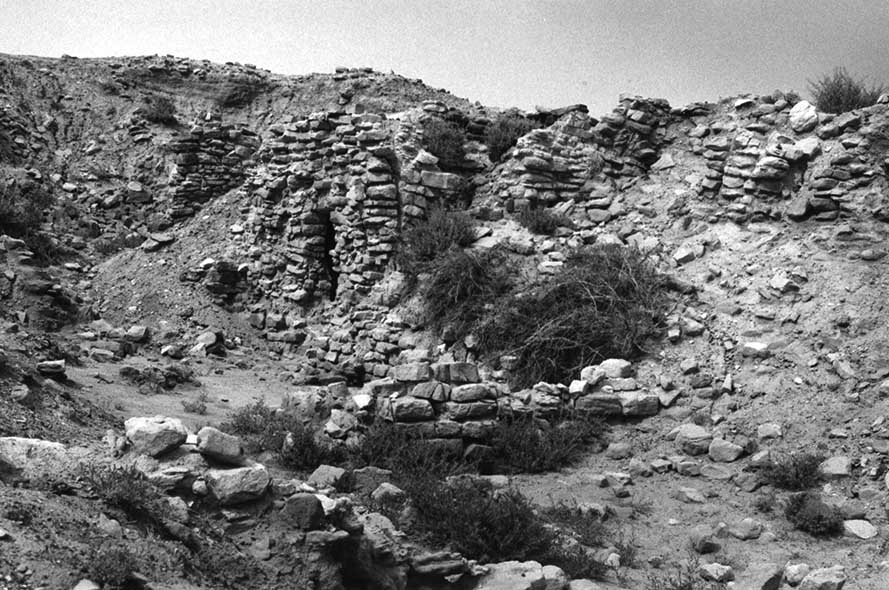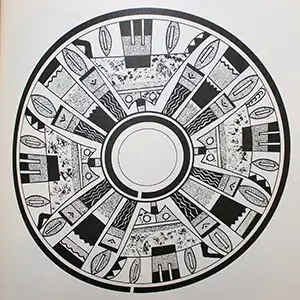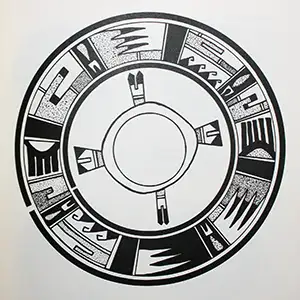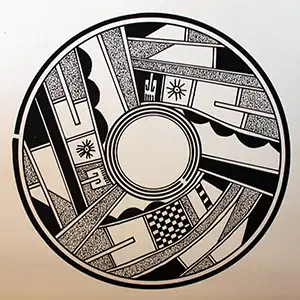Awat'ovi

Detail from a restored wall mural found in a kiva at Awat'ovi
Awat'ovi was founded around 1200 CE on a defensible point overlooking the Jeddito Valley on the southern side of Antelope Mesa. Today's Jeddito Valley contains many ancient abandoned pueblos but Awat'ovi is by far the largest and most spectacular. It's not that there's much to look at as there isn't: the excavated areas have been mostly backfilled and there isn't much showing above the surface. But there are broken potsherds all over the place, so many sherds that it has been said the residents of Awat'ovi formed, decorated, fired and then broke pottery non-stop, morning, noon and night for hundreds of years.
Awat'ovi came into being at a time when the concept of clans was first emerging. It is said that Awat'ovi was founded by members of the Bow Clan but many other clans came and went over the years. It seems most of the pueblos built in the environs of Antelope Mesa were built by people from the north and east. First Mesa was a form of interface between the eastern people and the western people as many of the clans and societies of the First Mesa area practice rituals similar to those practiced in the Keres, Tewa and Towa pueblos closer to the Rio Grande. They even sing their stories in archaic versions of those same languages. Walpi, Shungopovi and Hano are living examples of that. Some of those same clans and rituals are common to other Hopi villages on Second and Third Mesas but there are subtle differences depending on the physical and spiritual distance each is from First Mesa.
The 1200s were also a time of great dislocaton as the climate changed considerably for the drier and families and clans migrated cross-country to be closer to more reliable sources of water. Betatakin and Kiet Siel were built in the mid-1200s with grain storage rooms much larger than usual. Then both were abandoned before the end of the century as they couldn't grow and store enough grain to keep their people alive. The pueblos of Hovenweep, the Little Colorado River, the Lower San Juan and others were abandoned. Many of those people added to the populations of Hopi First, Second and Third Mesas but not necessarily to any of the Antelope Mesa/Jeddito pueblos.
As more and more Towa and Keres-speaking people (mostly coming from the Kayenta and western Mesa Verde regions) migrated to the Antelope Mesa area, the more the clans and kachinas came to have local presence. There was also a long history of Zuni influence in the area as many Zunis, Acomas, Lagunas and Hopis trace the migrations of their families and clans back to ancient sites found in the Fourmile/Casa Malpais and Wenima areas in eastern Arizona.
I also say the folks migrated south from the Kayenta area and southwest from the Mesa Verde area. They could just as easily have migrated west from the Rio Grande area or from the Aztec/Chaco Canyon areas. There was movement in the south, too, as the Salado and Mogollon people were also looking for better climate and water supplies.
Archaeologists say that at its height, Awat'ovi was a Towa-speaking pueblo first and Keres-speaking pueblo second. Nearby Kawaika'a was primarily a Keres-speaking pueblo. Both pueblos were on the southern side of Antelope Mesa, well across Jeddito Wash and away from the Hopi pueblos on First, Second and Third Mesas. Awat'ovi and Kawaika'a were also in an area where there were multiple other ruins from pueblos already long abandoned. Due to the nature of how the various clans came together to become "Hopi," multiple languages have seemingly always been spoken across the region. Even today, the Hopi spoken at Walpi is different from the Hopi spoken at Oraibi, same as the Keres spoken today at Acoma is quite different from that of a Keres-speaker from Santo Domingo or San Felipe.
Jeddito yellow clay is part of what made some of the pottery of those days so spectacular: it could be easily formed, polished and decorated, then fired with local coal. There were also other local clays that turned red and buff-colored when fired. The first orangeware appeared around 1275, the first yellowware around 1325. The coal came out of seams exposed along the sides of the mesas and it burned hotter than any other fuel they had access to. That extra heat had to be accounted for but it also made the pottery a bit more durable. The coal they used was very soft and had to be used almost as soon as it was dug out of the ground. So their firing pits were along the foot of the mesas, right next to the coal seams.
Between 1375 and 1425 certain styles of wall mural, textile and pottery decoration were developed at Pottery Mound, on the banks of the Rio Puerco in central New Mexico. We don't know where the people who first built Pottery Mound came from but the village was a veritable melting pot of artistic and religious styles and designs. Toward the end of that time period there was a small migration of people from the Jeddito Valley to Pottery Mound. That migration reversed direction about 50 years later and some of that design and style innovation made the return trip.
I bring up Pottery Mound because when that pueblo was excavated, underground kivas were found with particular designs painted on the walls. Textiles were found with portions of some of those designs dyed into them. And there was pottery found with aspects of those designs transferred from 2-dimensional renderings to 3 dimensional renderings. The dating of the artifacts and murals is put at between 1375 and 1425 CE.
It is felt that the designs were of spiritual significance as it must have taken quite some time to prepare and paint those kiva murals, create and dye the textiles appropriately, form and decorate the pottery and develop the rituals. As kivas are known centers of religious activity within the pueblo, the supposition is that the designs, textiles and associated rituals were specific to the development of a particular clan. It is felt that in the creation of the murals of Pottery Mound, ritual specialists may have evolved and a clan formed around that purpose. However, any clan so formed was quite small in number and reach. Wall murals of simpler design and similar age have been found at Kuaua, Kawaika'a and Awat'ovi. Only one kiva mural has been found at Awat'ovi in which layers are painted with various clearly (what became known as) "Sikyátki" designs.
Many of the designs that are now termed "Sikyátki" were actually first expressed in the Fourmile Ranch/Casas Malpais area. Some were also developed at Homol'ovi but that was only shortly before the Homol'ovi pueblos were abandoned and most of those people moved to the Hopi mesas. It's possible the real flow of Sikyátki-style began to develop at Pottery Mound and was transplanted to Awat'ovi where it probably came to the attention of Sikyátki potters through regional trade.
The wall murals at Pottery Mound depicted kilts, blankets and other painted textiles but no evidence of them has been found at Hopi. As textiles are a more easily transported medium than pottery, it makes sense that those designs made the journey to the Hopi mesas painted on religious garments. At least one ritual specialist made the journey to Hopi and for maybe 30 years, faithfully performed his/her duties in rendering versions of those designs on the walls of a kiva built for that purpose. However, rather than being a rendering similar to that of an unfolded/unrolled paper map, the viewpoint of some of the painting is spherical, from a polar angle, with the elements of the design radiating outward from a centerpoint. That's how it would be if the surface of a painted pot were flattened. Apparently that clan didn't get a lot of support at Awat'ovi as the painting of those murals ended before 1450 and that kiva was closed by 1500.
There's a large difference between the vocabulary that can be expressed on the large surface of a flat wall and what can be expressed on the globular surface of a pot you hold in your hand. A potter, looking at a painted wall, could probably only grasp smaller elements of that whole and then transfer those smaller elements to the surface of a pot. That's likely how "Sikyátki" designs spread across the Hopi mesas: in bits and pieces.
The elders of Awat'ovi had long been involved in recruiting new clans and ritual specialists into Awat'ovi society. By the early 1500s, that effort had helped Awat'ovi become the largest and most prosperous pueblo in the region. It was also the first pueblo in Tusayan approached by the Spanish in 1539.
That first contact between Hopi elders and Spaniards: The chief of Awat'ovi held out his hand, expecting the Nachwach clan handshake (the Handshake of Brotherhood) in return. Pedro de Tovar, head of the Spanish expedition, looked at that hand and, like the arrogant Spanish nobleman he was, he asked his men to give him a coin, then dropped that coin in the open palm. The Awat'ovis were rightfully insulted and if the Spaniards had not had their guns, they'd all have been killed on the spot. As it was, weapons were drawn and fighting started but ended quickly as the elders of Awat'ovi sued for peace and offered appropriate gifts.
Soon the other major Hopi pueblos (Oraibi, Mishongnovi, Walpi, Kawaika'a and Sikyátki) followed suit. The Spaniards searched thoroughly and, finding no gold, left. Various explorers appeared over the years but none came to stay until the first Franciscan friars appeared at Awat'ovi in 1629.
The village of Sikyátki was destroyed in 1625. The padres saw what remained of that recently destroyed pueblo but didn't take any hints from it. Backed by Spanish troops, the fathers forced the people to build the San Bernardo de Aguatubi Mission on top of the former primary kiva of the pueblo. Construction of the mission required the cutting and transport of large pine logs across the desert from the Chuska Mountains, more than 100 miles away. The mission is reported to have been open for business in 1629, indicating a massive disruption of the people, their religion and their labor. A clear marker in the pottery tradition was the appearance of San Bernardo Polychrome, a product produced at Awat'ovi after 1629.
The fathers weren't doing too well in converting the residents until one of them successfully treated the eyes of a young boy. As the people felt that to be a miracle, some of them began to convert and be baptised. As that was a threat to the dominance of Hopi religious authorities, that priest was dead (most likely poisoned) less than four years after his arrival at Awat'ovi. However, religious conversions continued. Satellite missions were established at Oraibi, Mishongnovi and Walpi but they weren't doing well as Hopi hostility grew more organized. The situation led to continually escalating abuse by the Spanish until one day in 1680, they were all killed and their missions razed during the 1680 Pueblo Revolt.
Franciscan fathers reappeared in the area in 1696 and ordered the reconstruction of San Bernardo de Aguatubi Mission. The chief of Awat'ovi decided that his people had strayed too far from their Hopi traditions and conspired with leaders of other Hopi pueblos to destroy Awat'ovi. Then came a morning in early 1701 when the men of Awat'ovi were in their kivas (the pueblo chief included, he did not spare himself) and the men of other Hopi pueblos attacked.
They pulled the ladders up out of the underground kivas and poured wood and burning pitch down. They also poured in masses of chile peppers (Awat'ovi was known for the quality of their chiles) and killed most of the men and boys that way (certain ritual specialists, from clans not represented among the other Hopi pueblos, had been warned in advance and were spirited away to other pueblos).
The women and girls were rounded up and some were being systematically executed when a deal was struck to divide the remainder among the other pueblos. That didn't go so well for the women either as most of them did not survive the trip to those other pueblos. When the division of spoils was finished, what was left of Awat'ovi was burned. The site was never settled again.
There were several archaeological expeditions to Awat'ovi over the years but these days, most visitors are Hopis collecting designs from the pot sherds and rock art in the surrounding canyons. The site of Awat'ovi can be toured by non-Hopis but that requires the presence of a Hopi guide. Many people who have walked on that hallowed ground report sensing multitudes of disturbed spirits still present.

Some of what's left of Awat'ovi
Design patterns are from Historic Hopi Ceramics
Sites of the Ancients and approximate dates of occupation:
Atsinna : 1275-1350
Awat'ovi : 1200-1701
Aztec : 1100-1275
Bandelier : 1200-1500
Betatakin : 1275-1300
Casa Malpais : 1260-1420
Chaco Canyon : 850-1145
Fourmile Ranch : 1276-1450
Giusewa : 1560-1680
Hawikuh : 1400-1680
Homol'ovi : 1100-1400
Hovenweep : 50-1350
Jeddito : 800-1700
Kawaika'a : 1375-1580
Kuaua : 325-1580
Mesa Verde : 600-1275
Montezuma Castle : 1200-1400
Payupki : 1680-1745
Poshuouingeh : 1375-1500
Pottery Mound : 1320-1550
Puyé : 1200-1580
Snaketown : 300 BCE-1050
Tonto Basin : 700-1450
Tuzigoot : 1125-1400
Wupatki/Wukoki : 500-1225
Wupatupqa : 1100-1250
Yucca House : 1100-1275


